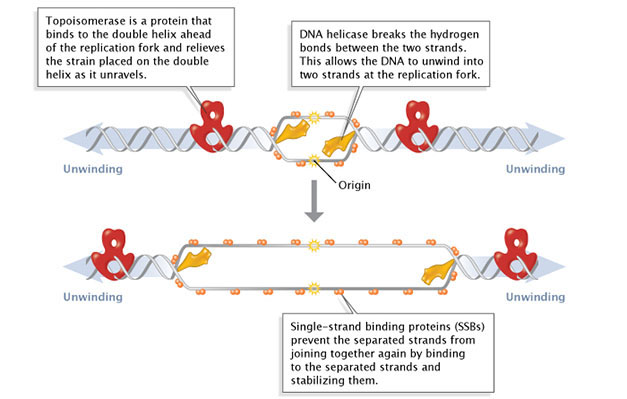Which Best Describes the Function of Helicase in Dna Replication
Other proteins assist helicase to keep the strands apart as long as required for the replication process. This allows free DNA nucleotides to attach to their complementary pair.
DNA helicase acts to unwind the 2 strands of DNA by breaking the Hydrogen bonds between them.
. It unwinds the double helix at the replication fork to allow DNA polymerase to progress along the DNA. Add your answer and earn points. A It is an enzyme that polymerizes to the DNA and keeps the replication fork open B It is an enzyme that catalyzes the addition.
14 Which of the following best describes the function of helicase. What is the function of the sliding clamp in DNA replication. The limited helicase processivity of UvrD may be tailored for its functions in NER or MMR which require the unwinding of relatively short duplex DNA tracts as compared with unwinding at the replication fork in which many thousands of bp are typically encountered by the bacterial replicative helicase DnaB see Replicative Helicase section below.
Helicase unzips the DNA strand while DNA polymerase brings in new strands of DNA to match the old strands. B It unwinds the DNA double helix. Biology tutor 3888 Views See similar Biology A Level tutors Need help with Biology.
DNA polymerase is the main enzyme that polymerises the DNA strands during replication. This means that free nucleotide bases can be attracted and bind to the exposed bases. Animals which generally possess only one PIF1 homologue use the helicase for functions similar to those described for yeast.
Helicase is the enzyme that unwinds the DNA by breaking hydrogen bonds between the two strands. DNA helicase is a Hexameric ring shaped ATP Hydrolyzing Enzyme acted on Double stranded DNA helix AAAATPase family. Helicase is an Enzyme which will open the dsDNA into ssDNA strands by breaking the H- bonds between the nitrogen bases.
Helicase unzips the DNA allowing replication proteinsenzymes in to access the DNA and start replication. DNA Polymerase Polygenic Inheritance. SSDBPs or single strand DNA binding proteins bind to open strand formed by helicase action and keep them as a s.
Each resulting DNA contains 1 strand of the original and 1 newly synthesized strand. DNA helicase unwinding DNA and breaking hydrogen bonds between DNA strands 1 mark 2. DNA polymerase reads the original strand and brings in complementary nucleotides to form the complementary strand notice how the result is semi conservative.
DNA replication occurs in two phases. DNA helicase is involved in the early steps of DNA replication. DNA helicase is the zipper.
It unzips our DNA strands to allow space for attachment and to expose the nucleotides that. Its loaded onto Unwinded DNA with the help of DnaC protein as in Ecoli one on each DNA strand. Answered by Rachel M.
DNA polymerase breaks down the old strand of DNA after a new one has been replicated while helicase connects the two DNA strands together. Like opening DNA helicase. It breaks the hydrogen bonds between the complementary base pairs to expose the bases on the original strand of DNA.
DNA separation DNA helicase and DNA transcription DNA polymerase Enzyme Function. It keeps DNA polymerase firmly attached to the template while it synthesizes a new strand of DNA. 3 rows function dna helicase dna replication FAQwhat the main function dna helicase dna.
Enzymes that are responsible for replication of DNA can only bind to a single strand of DNA. 1 new DNA molecule 1 old molecule is conserved. DNA helicase is important in DNA replication - explain why.
А helicase B endonuclease ligase D DNA polymerase O primase Submit Answer hon Which of the following statements best describes DNA polymerase. A It helps keep the DNA strands separated after the replication fork. Replication forks Dna double helix is separated into single stands by the enzyme dna helicase newly-exposed unreplicated dna is protected by single stand binding proteins short segments of rna are synthesized called RNA Primers the enzyme that synthesizes the short segments of rna is called a Primase.
2 DNA molecules that each contain a strand of the original. DNA replication is semiconservative one original strand is retained and one strand is newly formed in the DNA duplex. 2 completely new DNA molecules.
It forms the so called replication fork. 1 new molecule of RNA. DNA polymerase joins adjacent nucleotides OR forms sugar- phosphate backbone 1 mark Analogy to remember.
9 rows Unwinding the double-stranded nucleic acid DNARNA is a major function of any helicase. This is best explained as a function of Rrm3 as a component of the replisome strengthening the force of the replicative helicase MCM2-7 for fork movement through pausing sites Torres et al 2004. It hydrolyzes ATP to power the movement of DNA polymerase along the DNA template.
Its moving from 5 to 3 direction in the lagging strand of a Replication fork and unwinds the DNA to recruit DNA polymerase. This is very similar to the role that DNA helicase plays in DNA replication. C It adds nucleotide bases to the newly synthesized DNA strand.
Alewis24246 is waiting for your help. DNA replication results in. The main function of DNA helicase is to separate two strands of DNA for replication.
D It joins together the Okazaki fragments produced from the lagging strand.

Molecular Events Of Dna Replication Learn Science At Scitable
No comments for "Which Best Describes the Function of Helicase in Dna Replication"
Post a Comment